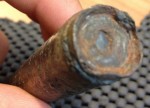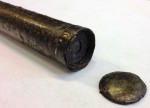
The oldest telescope in the Netherlands was discovered during digging for a new subway tunnel in Delft. Just four inches long and heavily corroded, the device was first thought to be an old shell casing, but the city archaeologist saw what looked like glass pieces at both ends and forwarded it to the Boerhaave Museum in Leiden for their experts to examine.
 Conservators cleaned the instrument and found under all the layers of corrosion that it was made of tin, the metal used in the earliest telescopes. Its original cap was still attached. Both lenses were removed and cleaned. They’re 12 millimeters in diameter with an irregular shard-shaped perimeter. The eyepiece is flat on one side and concave on the other. while the lens is flat on one side and convex on the other, construction typical of the first generations of telescopes. The quality of the glass is abysmal, full of bubbles with uneven grinding. Only the middle five millimeters of the lenses are ground well enough to function.
Conservators cleaned the instrument and found under all the layers of corrosion that it was made of tin, the metal used in the earliest telescopes. Its original cap was still attached. Both lenses were removed and cleaned. They’re 12 millimeters in diameter with an irregular shard-shaped perimeter. The eyepiece is flat on one side and concave on the other. while the lens is flat on one side and convex on the other, construction typical of the first generations of telescopes. The quality of the glass is abysmal, full of bubbles with uneven grinding. Only the middle five millimeters of the lenses are ground well enough to function.
 Despite their inherent limitations, once cleaned the lenses actually worked. Conservators put the telescope back together and were able to see through it at five times magnification. That would not have been sufficient for military use or for astronomy (in any case it took Galileo for the first looking glasses to be pointed up to the sky). It was a wealthy person’s plaything, basically, used to get a better view at public gatherings, perhaps, or to get a better view of the stage at the theater.
Despite their inherent limitations, once cleaned the lenses actually worked. Conservators put the telescope back together and were able to see through it at five times magnification. That would not have been sufficient for military use or for astronomy (in any case it took Galileo for the first looking glasses to be pointed up to the sky). It was a wealthy person’s plaything, basically, used to get a better view at public gatherings, perhaps, or to get a better view of the stage at the theater.
 The shapes of the lenses, the bubbles in the glass, the uneven grinding and the use of tin strongly suggest it was manufactured before 1650. After that, tin was replaced by brass and other more durable metals and the quality of glass and grinding were vastly improved. The general appearance of the telescope is also in keeping with prints from the first half of the 17th century. Neither is it likely that the telescope was made later but on the cheap. There are remnants of gilding on the tin, which means when first produced, this piece was an expensive luxury item. Nobody would spend money on a gilded telescope but use primitive lenses in it unless those were the only kinds of lenses available.
The shapes of the lenses, the bubbles in the glass, the uneven grinding and the use of tin strongly suggest it was manufactured before 1650. After that, tin was replaced by brass and other more durable metals and the quality of glass and grinding were vastly improved. The general appearance of the telescope is also in keeping with prints from the first half of the 17th century. Neither is it likely that the telescope was made later but on the cheap. There are remnants of gilding on the tin, which means when first produced, this piece was an expensive luxury item. Nobody would spend money on a gilded telescope but use primitive lenses in it unless those were the only kinds of lenses available.
 The telescope was invented in Middelburg in 1608, but until this find, the oldest one in the Netherlands dates to 1669 (it’s at the Boerhaave Museum along with the next oldest from 1683). Because tin corrodes so easily, none of the earlier ones were known to have survived. This one was found in an old canal where the low oxygen environment kept it from rusting into nothingness. There’s even a very slim chance that it’s the oldest telescope in the world, but it’s highly unlikely. There’s only a tiny window of possibility since Galileo started making his in 1609, the year after the first patents applications were filed in the Netherlands and the Museo Galileo in Florence has two of his from 1609-1610.
The telescope was invented in Middelburg in 1608, but until this find, the oldest one in the Netherlands dates to 1669 (it’s at the Boerhaave Museum along with the next oldest from 1683). Because tin corrodes so easily, none of the earlier ones were known to have survived. This one was found in an old canal where the low oxygen environment kept it from rusting into nothingness. There’s even a very slim chance that it’s the oldest telescope in the world, but it’s highly unlikely. There’s only a tiny window of possibility since Galileo started making his in 1609, the year after the first patents applications were filed in the Netherlands and the Museo Galileo in Florence has two of his from 1609-1610.
The telescope is going on display at the newly renovated De Prinsenhof Museum in Delft for it’s grand reopening on May 23rd.